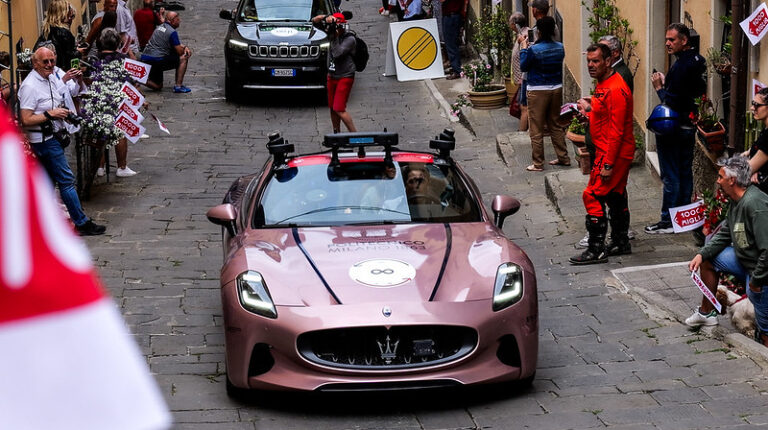How the Artificial Intelligence Driving Autonomous project is advancing AV technology through rigorous testing, transforming insights from competitive racing into solutions for urban driving challenges
Please provide an overview of the Artificial Intelligence Driving Autonomous (AIDA) project and its significance in the context of autonomous driving research and development.
AIDA is a large-scale project focused on developing autonomous driving in urban environments. Leveraging the legacy and achievements of the PoliMOVE Autonomous Racing team, I assembled a team of young researchers and engineers to tackle the challenges of integrating autonomous vehicles into urban settings. Unlike in the controlled conditions of a competition, AIDA vehicles must navigate diverse scenarios, such as those found on Italian roads, and handle the unpredictability of other road users.
What were the main objectives for Politecnico di Milano in participating in this year’s 1000 Miglia?
The AIDA team participated in the 2024 edition of the 1000 Miglia Autonomous Drive (MAD) race with a dual objective: testing their technology over at least 300km of autonomous driving and collecting data along the entire 2,200km competition route. This route included a variety of driving scenarios, such as cities, historical towns, highways and suburban roads, providing valuable information for further development.
How did the development team prepare the Maserati GranCabrio Folgore for the 1000 Miglia, particularly in terms of its autonomous driving capabilities?
To prepare for the competition, the AIDA team modified a standard production car by integrating all the necessary devices to run autonomous driving algorithms. These included various sensors, such as lidar, cameras, radar and GNSS antennas, to determine the vehicle’s position and surroundings. A computer was installed to execute the control algorithms, and actuators were added to the steering wheel and brake pedals to manage the vehicle’s movements. Antennas were installed for remote connectivity, and a human-machine interface was set up to enable supervision of the autopilot and allow the co-pilot to monitor the vehicle’s status via a dedicated screen. Additionally, the system was integrated with the car’s software to collect driving data and digitally control the throttle. Finally, a sculpture called ‘avatar’, representing artificial intelligence and its role in controlling the vehicle, was placed on board.

What were the key technical advances made since last year’s race, enabling the vehicle to complete over 300km in autonomous mode compared to the previous 60km?
Multiple factors contributed to covering five times more kilometers than in the 1000 Miglia 2023 edition. First, the vehicle setup was enhanced with improved sensors, enabling higher-resolution data collection. The algorithms were thoroughly revised to be more robust, leveraging the data collected during the 1000 Miglia 2023 edition. Regulatory work was also crucial. This year, the team secured approval from the Ministry of Infrastructure and Transport to test autonomous driving on over 1,000km of public roads along the entire competition route for 12 months (obtaining permission to test autonomous cars on public roads open to traffic is still extremely difficult in Italy and in Europe in general). This approval allowed the team to continually test and refine their algorithms on real roads. Finally, a larger, stronger and more experienced team played a key role in this year’s success.
What specific challenges did the variety of routes in the 1000 Miglia present to the autonomous driving system? Why is this route such a unique testbed?
The 1000 Miglia offers a unique opportunity to tour northern and central Italy through various driving contexts. In just a few days, the AIDA team traversed more than 2,200km of public roads, including modern cities, highways, mountain roads in the Apennines and narrow streets in medieval towns. The competition also provided access to roads typically closed to public traffic, which are crucial for training the algorithms in very diverse situations. Additionally, the 1000 Miglia’s open-traffic route allowed the AIDA team to test their technology in real-world conditions.
How did the autonomous system handle the diverse driving conditions, from village roads in the Apennines to motorways and city boulevards?
The autopilot performed exceptionally well in the diverse contexts where we tested autonomous driving. The AIDA team dedicated significant effort to developing algorithms that are reliable and safe in every road scenario, as these are crucial requirements for operating autonomous driving systems on public streets and interacting with other road users.
Can you share any specific instances or scenarios from the race where the autonomous driving system performed exceptionally well or faced significant challenges?
During the 1000 Miglia 2024 edition, we tested the system in an extra-urban context for the first time, and the algorithms responded very well. However, the most challenging scenarios were within the cities, where narrow streets were crowded with unpredictably moving pedestrians. Although our algorithms are already secure, we need to further optimize them to enhance their predictive capabilities.
What types of data were collected during the race, and how is this data being used to improve the autonomous driving system?
During the 1000 Miglia, the AIDA team collected driving data along the entire route for several purposes. First, this data is essential for training AI algorithms to enhance their performance. Additionally, the data is used to refine the control algorithms, thus improving their accuracy and precision. The environmental data collected will be leveraged to create a detailed reconstruction of the streets that the vehicle traversed, aiding in simulating new tests and making the algorithms more robust for navigating similar environments. Lastly, data on the vehicle’s dynamics, combined with qualitative feedback from the co-driver, will help the AIDA team enhance the onboard experience, making it more enjoyable for passengers.
What role did you and your team play in the development and testing of the autonomous system?
The AIDA team oversees the entire process of transforming a production car into an autonomous vehicle. The researchers’ work begins with selecting a hardware setup and installing the necessary hardware on the car and integrating these components. They then develop the algorithms that control the autopilot. Additionally, the team handles the ministerial authorization required for testing on public streets. Finally, they analyze the data gathered during testing sessions to further refine and improve the algorithms and the overall driving experience.
How do you foresee the advances demonstrated in the 1000 MAD experimentation influencing the future design and development of autonomous vehicles?
The AIDA team has demonstrated that autonomous driving technology can be effectively used on public streets, a context characterized by high complexity and uncertainty. The team will now focus on two complementary but important aspects of the research. First, they will test the technology in challenging conditions, as done on the Vallecamonica hillclimb track in July 2024. This will help study how the AIDA solution behaves in critical scenarios and consequently strengthen the algorithms for ordinary conditions. Second, the team will test the technology on city cars, moving a step forward to large-scale adoption of this innovation.
Are there any specific areas of improvement or new technologies that you plan to focus on for future projects of AIDA?
The team is continuously committed to enhancing the technology, aiming to improve results and performance and further demonstrate the safety and effectiveness of our autonomous driving systems. Follow the team’s journey on Instagram and LinkedIn.


